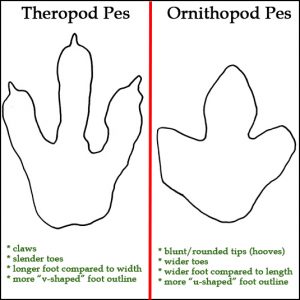Dinosaurs Left Tracks Thanks to the “Goldilocks” Effect
Manchester Researchers Reveal Secret to Dinosaur Tracks
A team of researchers based at Manchester University (England) have identified the ideal conditions needed for dinosaur tracks to be preserved as trace fossils. Footprints and trackways are known as trace fossils. These preserve evidence of the activity of animals, they have one major advantage over the other main type of fossil – body fossils, they are direct in situ evidence of the environment at the time and place the organism lived. If you were to stand in the preserved, fossilised footprint of a dinosaur, you will literally be “walking with dinosaurs”.
Dinosaur Tracks
University of Manchester researchers used computers to simulate prehistoric creatures making tracks in different types of mud. This university has developed an extensive range of software programmes which have led to insights into dinosaur travel speed and locomotion. The team found that soil conditions had to be perfect for different dinosaurs to leave fossil footprints behind.
Computers Used to Assess Dinosaur Trackways

Picture credit: Manchester University
Dubbed the “Goldilocks effect”, scientists say it explains why tracks were left at some sites and not others.
Dr Peter Falkingham, who led the research team stated:
“By using computer modelling, we were able to recreate the conditions involved when a 30-tonne animal makes a track.”
He went onto add:
“Now we can use this Goldilocks effect as a baseline for exploring more complicated factors such as the way dinosaurs moved their legs, or what happens to tracks when a mud is drying out.”
The Diversity of the Dinosauria
Dinosaurs were incredibly diverse over their 160 million year reign, ranging from leviathans that weighed upwards of fifty tonnes to tiny, bipeds such as Compsognathus from Germany and Microraptor from China. However, different sites and different strata have yielded different tracks.
The Paluxy River site in Texas, USA – where one of the most famous sets of fossil prints was found – only reveals prints of larger dinosaurs. Using computer modelling, the team simulated up to twenty different dinosaurs walking in different conditions. What they found was that heavier dinosaurs only left lasting tracks in thick, shallow mud.
In deeper, softer mud, only lighter dinosaurs could leave prints while larger animals would become stuck and trapped in the soft mud they could die.
Dinosaur Tracks Reveal Secrets
Picture credit: Everything Dinosaur
The findings also suggest that significant sites such as Paluxy River could have been host to a larger number of creatures than the tracks themselves show. The fauna of an area was probably a lot more diverse than the footprint record reveals.
Dr Falkingham commented:
“A skeleton is the remains of a dead animal; the footprints are the remains of a living animal, something made during life. That’s what is absolutely fascinating for me about dinosaur footprints.”
For models and figures of dinosaurs and other prehistoric animals: Dinosaur Models and Prehistoric Animal Replicas.


